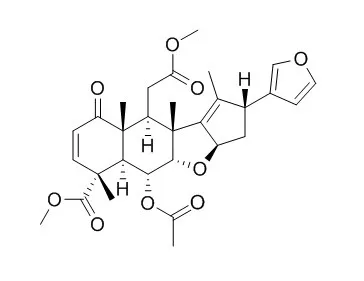| Description: |
Nimbin is an anti-pyretic, can be used to treat arthritis, hypoglycaemia, peptic ulcers, anti-secretory activity, and it can also be used as an antibiotic. Nimbin requires to elicit a 50% inhibition of this steroid hydroxylase activity in the three insect species examined ranged from approximately 2 x 10(-5) to 1 x 10(-3). Nimbin also shows anti-feedant activity and toxicity against larvae of three species of Lepidoptera, Spodoptera littoralis (Boisd), Spodoptera frugiperda (FE Smith) and Helicoverpa armigera (Hübner) and nymphs of the locusts Schistocerca gregaria (Forskål) and Locusta migratoria (L). |
| In vitro: |
| Pest Manag Sci. 2004 May;60(5):459-64. | | Comparison of anti-feedant and insecticidal activity of nimbin and salannin photo-oxidation products with neem (Azadirachta indica) limonoids.[Pubmed: 15154512] | Photo-oxidation of the neem limonoids Nimbin and salannin with UV light in the presence of oxygen gives two isomeric lactone products per limonoid, Nimbinolide and isoNimbinolide, and salanninolide and isosalanninolide, respectively.
METHODS AND RESULTS:
When compared in insect tests with the important limonoids of neem seeds, azadirachtin, Nimbin and salannin, isoNimbinolide and isosalanninolide show activity greater than that of Nimbin or salannin and in some respects show activity approaching that of azadirachtin.
The photo-oxidation products were tested for anti-feedant activity and toxicity against larvae of three species of Lepidoptera, Spodoptera littoralis (Boisd), Spodoptera frugiperda (FE Smith) and Helicoverpa armigera (Hübner) and nymphs of the locusts Schistocerca gregaria (Forskål) and Locusta migratoria (L). | | J. Food Eng., 2001, 47(4): 289-93. | | Supercritical CO2 extraction of nimbin from neem seeds - an experimental study[Reference: WebLink] | Nimbin is one of the many substances found in neem seeds and is reported to have several medicinal properties and uses. For example, it is an anti-pyretic, can be used to treat arthritis, hypoglycaemia, peptic ulcers, anti-secretory activity, and it can also be used as an antibiotic.
METHODS AND RESULTS:
In this paper, we present the results of a preliminary experimental study to extract Nimbin from neem seeds using CO2 supercritical fluid extraction (SFE). The operating pressure in the extraction was varied from 10 to 26 MPa, the temperature was varied from 308 to 333 K and the flow rate was varied from 0.24 to 1.24 ml/min. An optimum extraction rate was observed at a pressure of 23 MPa when operating at 308 K. Best extraction conditions occurred at 23 MPa, 308 K and a flow rate of 1.24 ml/min for a 2 g sample of neem.
METHODS AND RESULTS:
The measured extraction rate was found to be about 0.18 mg of Nimbin/g neem seed per hour of operation which is equivalent to about 0.35 kg Nimbin extracted per kg Nimbin present in neem seeds. | | J Alzheimers Dis Rep . 2019 Jun 14;3(1):169-178. | | Neem Derivatives Inhibits Tau Aggregation[Pubmed: 31259310] | | Abstract
Tau is a phosphoprotein with natively unfolded conformation that functions to stabilize microtubules in axons. Alzheimer's disease pathology triggers several modifications in tau, which causes it to lose its affinity towards microtubule, thus, leading to microtubule disassembly and loss of axonal integrity. This elicit accumulation of tau as paired helical filaments is followed by stable neurofibrillary tangles formation. A large number of small molecules have been isolated from Azadirachta indica with varied medicinal applications. The intermediate and final limonoids, Nimbin and salannin respectively, isolated from Azadirachta indica, were screened against tau aggregation. ThS and ANS fluorescence assay showed the role of intermediate and final limonoids in preventing heparin induced cross-β sheet formation and also decreased hydrophobicity, which are characteristic nature of tau aggregation. Transmission electron microscopy studies revealed that limonoids restricted the aggregation of tau to fibrils; in turn, limonoids led to the formation of short and fragile aggregates. Both the limonoids were non-toxic to HEK293T cells thus, substantiating limonoids as a potential lead in overcoming Alzheimer's disease.
Keywords: Aggregation; Alzheimer’s disease; limonoids; natural products; tau. |
|






 Cell. 2018 Jan 11;172(1-2):249-261.e12. doi: 10.1016/j.cell.2017.12.019.IF=36.216(2019)
Cell. 2018 Jan 11;172(1-2):249-261.e12. doi: 10.1016/j.cell.2017.12.019.IF=36.216(2019) Cell Metab. 2020 Mar 3;31(3):534-548.e5. doi: 10.1016/j.cmet.2020.01.002.IF=22.415(2019)
Cell Metab. 2020 Mar 3;31(3):534-548.e5. doi: 10.1016/j.cmet.2020.01.002.IF=22.415(2019) Mol Cell. 2017 Nov 16;68(4):673-685.e6. doi: 10.1016/j.molcel.2017.10.022.IF=14.548(2019)
Mol Cell. 2017 Nov 16;68(4):673-685.e6. doi: 10.1016/j.molcel.2017.10.022.IF=14.548(2019)